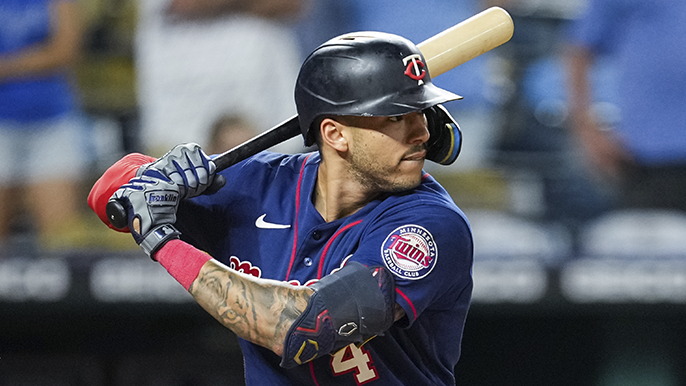
Even before Carlos Correa’s signing becomes official, one thing is clear: the Giants are spending with the big boys again.
In the history of baseball, only Bryce Harper, Julio Rodríguez, Giancarlo Stanton and Fernando Tatis Jr. have signed contracts 13 years or longer. Only Aaron Judge, Mike Trout and Mookie Betts have inked deals worth over $350 million.
For the last two years, the Giants front office has operated in the middle class. Concerns arose as to whether, or if ever, president of baseball operations Farhan Zaidi would dip into the superstar bucket and return San Francisco to the upper echelon of payroll.
Carlos Correa and his 13-year, $350 million contract — the most ever for a shortstop that also reportedly includes a full no-trade clause—obviously indicates the Giants are ready to cut real checks.
By landing Correa, the Giants are acting like what they are: a big-market team. In an environment in which you’re competing with the glitzy Los Angeles Dodgers and the all-in San Diego Padres, plus for attention with Bay Area sports powers Warriors and 49ers, there’s no other choice.
The Giants ranked 13th and 14th the past two Opening Days in payroll. They were eighth in 2020, but far closer to league average than the Yankees and Dodgers. It wasn’t always like that; from 2013 to 2019, the Giants were top-six spenders five times. Dollars don’t always equal wins, but that level of spending is appropriate for a franchise as storied and profitable as the Giants. And now, after years of Zaidi clearing the decks, the Giants are back at a healthy spot and ready to capitalize on it.
Signing Correa proves that Zaidi saying there haven’t been artificial constraints placed by ownership; that the front office doesn’t have hard-and-fast rules about mega deals; that the Giants are committed to winning; wasn’t just lip service.
It puts to rest the juvenile idea that Zaidi runs the Giants as if they’re the low-budget Oakland Athletics — for good.
It gives the facts that the Giants are the fifth most valuable MLB franchise — at $3.5 billion — and rake in an annual $32 million in operating expenses some tangible significance.
It confirms that the Giants care that the fans, the ones who sat out the 2022 season for the club’s lowest non-pandemic attendance total since moving to China Basin, value star power.
Just days ago, the Giants were at risk of going through an entire winter practically empty-handed. They struck out on Aaron Judge, the most prized free agent for whom they competed valiantly with the Yankees. Most of the brand-name free agents had already come off the board.
In the end, they’ve made their biggest free agent acquisition since Barry Bonds in Correa. They’ve added starting rotation depth with Ross Stripling and Sean Manaea, plus middle-of-the-order power with Joc Pederson and Mitch Haniger. The Giants have guaranteed over $463.2 million to those players in the past month.
Nobody, not even the Mets, has spent more this winter. Big market behavior.
Correa is the complete package. Since he won American League Rookie of the Year in 2015, he ranks 16th among position players in Fangraphs WAR. The two-time All-Star hit at least 20 home runs in six of his seven full seasons and owns impressive plate discipline. He elevates his game in the playoffs.
He’s the type of hitter who uncorks a go-ahead home run in the American League Championship Series and instantly taps his wrist at home plate — one of the coldest celebrations in recent baseball memory.
He’s the type of fielder to display a Platinum Glove award in his trophy room, as one of three shortstops to be named the best fielder in his league regardless of position since the honor started in 2011.
He’s the type of personality to take on a leadership role in the wake of Houston’s sign-stealing scandal when some of his teammates withered into the background. (Relatedly, he’ll sprinkle spice onto the Dodgers-Giants rivalry based on Houston’s history with Los Angeles).
At 28 years old and in his prime, he’s the type of player any club would want to build around. That’s why the Dodgers, Mets, Cubs, Red Sox and Yankees, the Blue Bloods, each reportedly had varying levels of interest.
Adding Correa brings questions. Does Brandon Crawford come off the position in 2023? What does this mean long-term for top prospect Marco Luciano? How much might the deal hurt in 2035 and 2036?
But those are the types of questions big market, contending teams face, the ones that matter only tangentially. They’re good problems to have.
The Giants’ payroll will likely exceed $170 million after deals get finalized. That will leave them with more room to add this cycle, and also with plenty of opportunity to be active again next winter when Shohei Ohtani hits free agency. In general, Correa’s relatively low $27 million average annual value should allow SF to continue committing resources to the roster.
San Francisco might never execute the frenzied spree A.J. Preller did to assemble a core of Tatis, Manny Machado, Juan Soto and Xander Bogaerts. They may never recreate the neverending conveyor belt of farm system talent the Dodgers have built to supplement their spending. They certainly won’t ever get to Steve Cohen Flushing levels of cash swirling.
Even though they demonstrated they could nickel and dime and platoon and fine-tune their way to 107 wins in 2021, adding star players around those core pillars makes the template more sustainable. There’s no reason the Giants can’t open their checkbooks when the right situation arises. They should operate like a paper printing powerhouse, not a penny pinching one.
Paying Carlos Correa more than double their previous franchise record suggests the Giants think so too.

